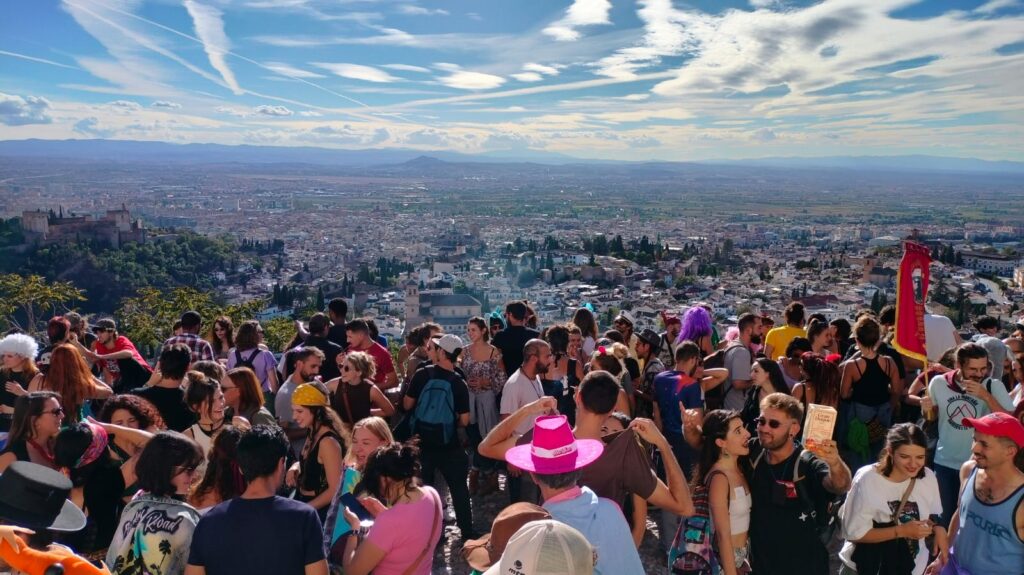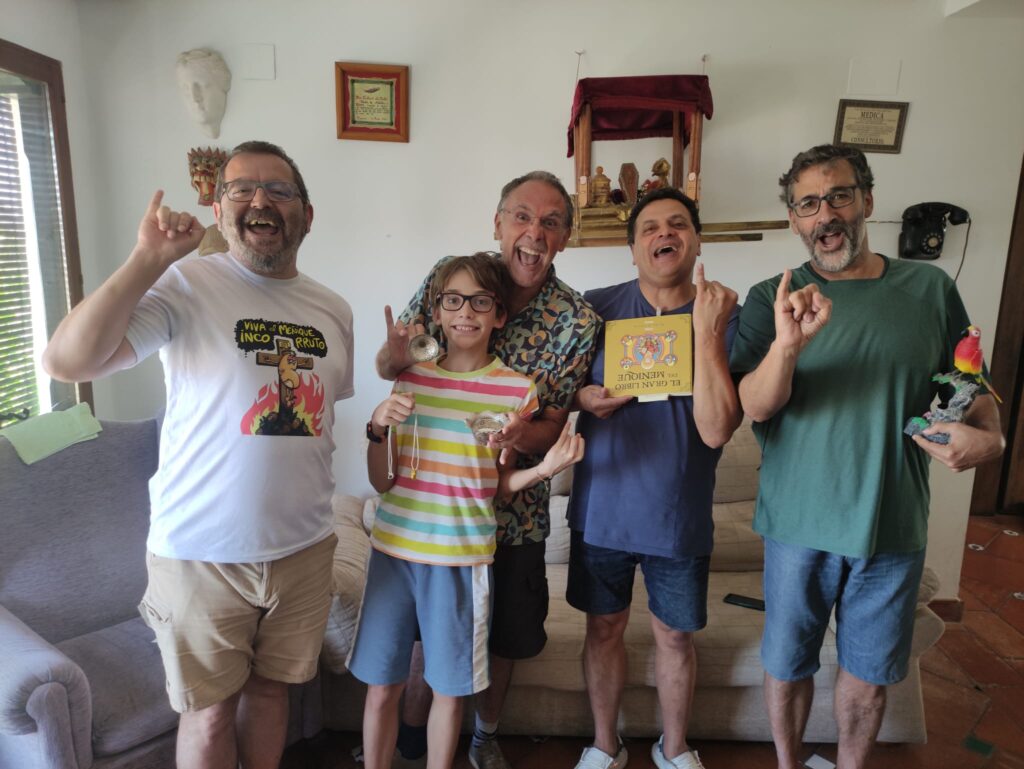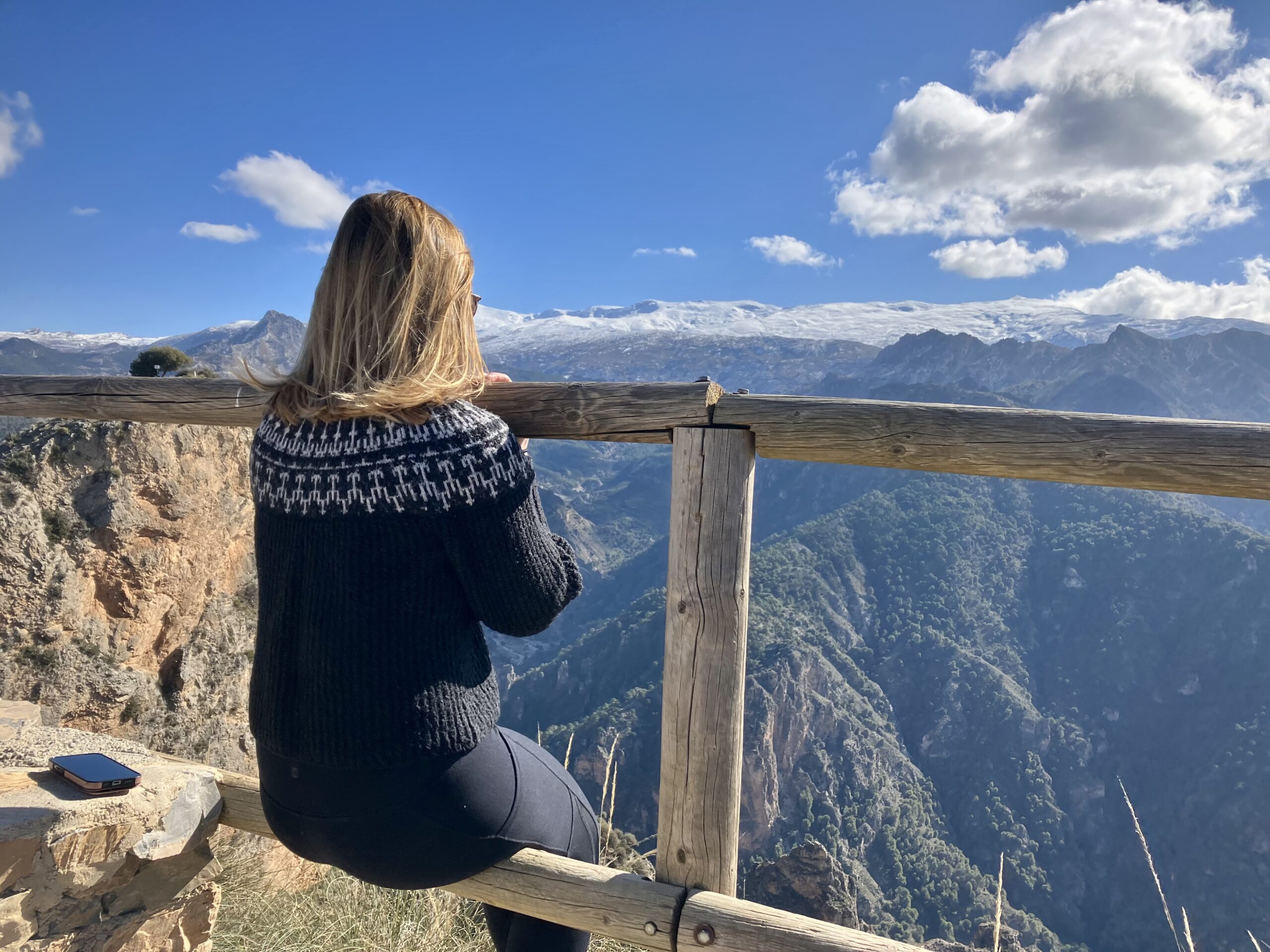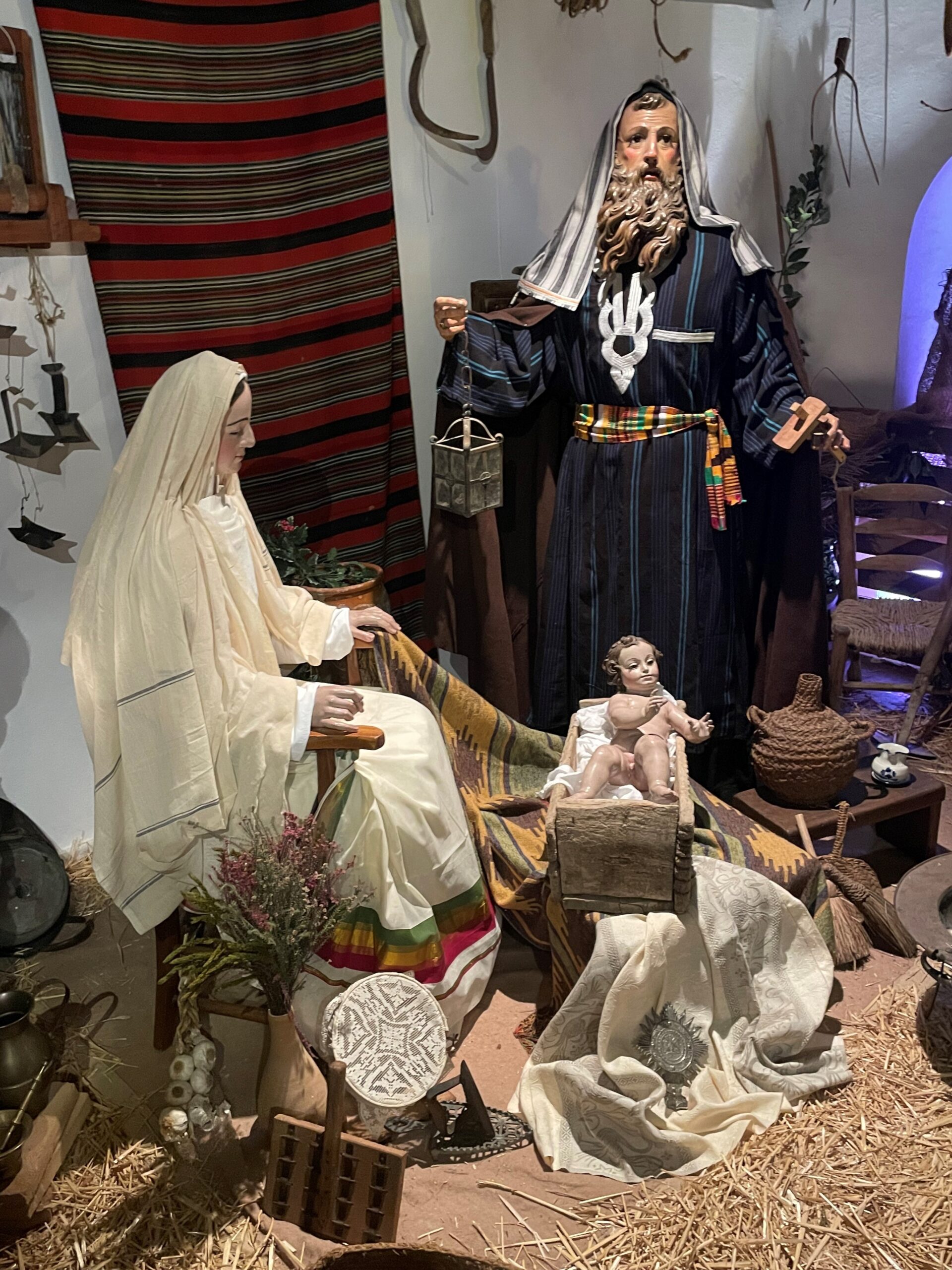On a scorching day in July, I met with the organizers of Granada’s most well-known secret festivity, the Romería del Meñique, the origins of which can be traced back to an accident where a man lost his pinky toe. Waiting for me in the kitchen of the Carmen del Meñique are Chemi Márquez, the man who lost his digit, along with Javi, Juanjo and Miguel (also known as “el Bute”). Chemi makes me a coffee, we all sit around the table, and embark on a nonsensical journey filled with laughter, craziness and joy.
How and when did the Romería del Meñique begin?
Chemi: It was noon on August 16, 1994. At the intersection of Gran Vía and Azacayas, a car collided with my motorcycle and, as a result, I lost the pinky toe on my right foot. The doctors tried to reattach it, but it didn’t work – it became gangrenous so they had to remove it again. They gave it to me in a plastic jar filled with formaldehyde, which I still have to this day.
Despite losing a toe, I wanted to celebrate the fact that I was alive and hadn’t sustained worse injuries in the accident, and so I threw a party. Some friends and I created a funeral-like atmosphere (for the toe, of course!) and placed candles along the stairs. My pinky toe was buried in its jar of formaldehyde accompanied by a ceremony and a prayer recited by José Manuel Salazar, who spoke backwards (from finish to start), and would later become the official priest of the event. Later, when I moved here to the Carmen del Meñique, we unearthed the toe and transferred it to my new home with an exequy attended by almost 50 people, including friends and friends of friends. This event spontaneously gave birth to the Romería del Santo Meñique Incorruto, the Pilgrimage of the Incorruptible Pinky Toe. (Note that in the spirit of rebellion, the event organizers intentionally opt to use the misspelled version of ‘incorrupto’.)
Where and when is the Romería del Meñique celebrated?
Juanjo: The Romería del Santo Meñique Incorruto has been celebrated continuously for 29 years on a random Saturday in October.
Miguel: It starts at the Carmen del Meñique and winds through the Albaicín up to San Miguel Alto.
Chemi: As far as we know, it’s the only procession in Spain that has been continuously held every year, even during the pandemic. That year, eight of us gathered with sandwiches and performed all the rituals via streaming. At the moment when the Santo Meñique, or the Saintly Pinky Toe, was to be brought out, there were 1,000 people connected online!
How has the Romería del Meñique evolved over the years?
Chemi: It started as a party among friends to celebrate the joy of living, which is what the Santo Meñique represents. Now, around 1,000 people attend every year, including local Granadinos, expats, and even tourists who see our crazy, costumed parade in the streets and join the procession.
Javi: It’s truly an unexpected and impressive outcome, considering that the only way to announce the event is through word of mouth among friends – it’s not on Facebook or Instagram. Besides, we don’t even know when it’s going to happen, as we decide on the date with very little notice.

How is it possible that 1,000 people participate each year, despite it being a secret celebration that’s not advertised anywhere?
Chemi: You find out the date of the Meñique (as the event is lovingly referred to) if you have good friends, not if you use social media.
Many foreigners participate in the Meñique and have a fabulous time. How has their presence grown over the years?
Juanjo: At first, the party was celebrated among friends, and suddenly there were nearly 1,000 people who didn’t know each other, celebrating the love of life.
Chemi: Little by little, foreigners living in the neighborhood and their friends joined through word of mouth, to the point that some interpreted it as an alternative tourist attraction, because the procession passed by Carrera del Darro, Mirador de San Nicolás, and wound its way up through the Albaicín to the top of San Miguel Alto, following a similar route to those of the Holy Week processions.
Why do you think this celebration appeals to everyone – Granadinos, Spaniards and the foreign community alike?
Javi: Because it’s an authentic celebration that we do for ourselves, not to entertain others.
Chemi: It’s a celebration of our right to live, where every human being can laugh at themselves, at others, at politics, at religion, at the environment… The joy of living, of which the Santo Meñique is a witness, is a value we all share universally as humans. That’s why people from all over participate in the Meñique.
The Romería del Meñique has a quasi-religious value, with its rituals and the coffin of the Santo Meñique Incorruto. Is it this kind of religiosity that has made it so well-known, or is there a hidden critique of religion, institutions, or politics?
Miguel: It has nothing to do with religion; this celebration is an ode to life, something stemming from the human need for transcendence.
Chemi: What do you do if you’ve had an accident? You laugh! That’s what the Meñique represents.
Juanjo: All kinds of people attend the Romería – even politicians and religious figures – who enjoy sharing the joy of living together. The Meñique is a break from everything, where there’s no intention to attack or criticize anything or anyone, but rather to laugh at everything and everyone, with respect.

The Meñique is a fun outdoor procession with food and drinks included, suitable for everyone, even families. Are any institutions involved or provide any kind of funding?
Juanjo: The Meñique neither has nor needs any institutional support; it’s timeless and doesn’t recognize the temporal authority of institutions. Mayors change every four years, while the Meñique has been celebrated every year since 1994, regardless of who’s in power. Also, the event doesn’t bother anyone because it is itinerant.
Chemi: The Meñique fights against the logic of the capitalist market. There’s no entry fee and drinks and sandwiches are free. Only little holy cards, or estampitas, of the Santo Meñique Incorruto are sold because it’s a tradition.
How long does it take you to organize the Meñique, and what does the preparation involve?
Chemi: The Romería doesn’t need preparation as it’s something very spontaneous, and no one knows what’s going to happen. The only things prepared are the costumes made by Miguel the day before and sandwiches of bread and “poor man’s mortadella” or “the stupid cousin of mortadella”. Sometimes we add tomato, and other times the sandwiches are all made with cheese for vegetarians.
Miguel: The day before the procession, our friend Enrique writes an ode to the Meñique (usually while sitting on the toilet), and Chemi prepares the secret cocktail that’s offered during the event. No one knows what’s in it.
Several brotherhoods participate in the Meñique each year. What is their role, and when did their participation start? How do you decide which brotherhood will win the Meñique de Oro, the sought-after Golden Pinky?
Chemi: The brotherhoods were spontaneously created to venerate the Santo Meñique Incorruto. The first one was from Adra, a town in the province of Almería, where faithful friends formed the first brotherhood and organized themselves to come to Granada. Then there was the Hermandad de Madrid, a brotherhood so large that its members slept everywhere in my house. Later came the Hermandad de la Santa Pata (the Holy Leg), which venerated the prosthetic leg of an Albaicín neighbor, whose memory is honored every year in the Meñique by passing through the Carmen de la Santa Pata. There, sandwiches and drinks are also offered to followers of the “Meñiquismo” movement. Over the years various groups have been formed, from Jerez to Seville, and today there’s PECERA, a brotherhood formed mostly by medical residents. Every year, the Meñique de Oro is awarded for merit in Meñiquismo, whose principle is “Don’t think about what the Meñique can do for you, but what you can do for the Meñique!” (Kennedy copied that phrase from me for his 1961 inauguration speech.)
What are the main rituals of the Meñique, and what is the craziest thing that has happened in the last 30 years?
Miguel: The first ritual is the baptism of the faithful attending the Romería for the first time. Adults are baptized at the Arco del Callejón de las Monjas in the Albaicín, and children at San Miguel Alto. The sacred rite consists of touching Chemi’s pinky toe with their right pinky toe.
Chemi: The idea of the baptism came when my daughter Alegría was born, and stems from a baptism ritual in Castrillo de Murcia, in eastern Spain, where children were laid on the ground and people jumped over them – hopefully without touching them. My wife prevented me from jumping over our daughter like that, and that’s where the tradition of touching pinky toes began.
Juanjo: Other rituals include passing through the Carmen de la Santa Pata, reading a new Ode to the Meñique written the day before, and mooning the Alhambra. The final indispensable ritual is that randomly chosen people must kiss Chemi’s right foot where the pinky once was. Last year, some 400 people kissed the stump! They say this act grants a wish, that’s why it is offered to anyone who needs it…
Javi: The craziest thing that happened at the Romería was years ago when the Santo Meñique was stolen, and people called from different phones to retrieve it. If Chemi wanted his Meñique back, he had to moon the Alhambra, and that’s when this tradition began.
Each year works of art are offered to the Santo Meñique: paintings, sculptures, poems, songs, dances and batucadas. Is something special planned for the 30th anniversary this year? And how were previous anniversaries celebrated?
Chemi: For the 20th anniversary, a model was made to recreate the accident, with ketchup used for blood. For the 25th anniversary, a historical compilation of the celebration titled El Gran Libro del Meñique, The Great Book of the Pinky Toe, was published.
Javi: This year, there will be a Rock Opera and an art exhibition, if we can find a space to exhibit all the works produced for the Meñique so far.
Can you reveal any other secrets surrounding this year’s anniversary?
Javi: In the 2024 Meñique, there will be a 3.0 version of the Meñique de Oro, made with a laser printer in almost pure gold.
And finally, why should people participate in your event?
Chemi: The collective energy at the Romería does not depend on the Meñique, but on people’s ability to be swept up by the will to live, to connect with one another in laughter and joy. It’s so important that we remember to enjoy life, and that we never forget to laugh!
P.S. My interviewees did not disclose the date for the 2024 Romería. If you’re in Granada in October and passing through the Albaicín, perhaps you can pop into a local bar or cafe and ask around with the locals. Maybe you will get lucky and someone will whisper the neighborhood’s worst-kept secret into your ear…





